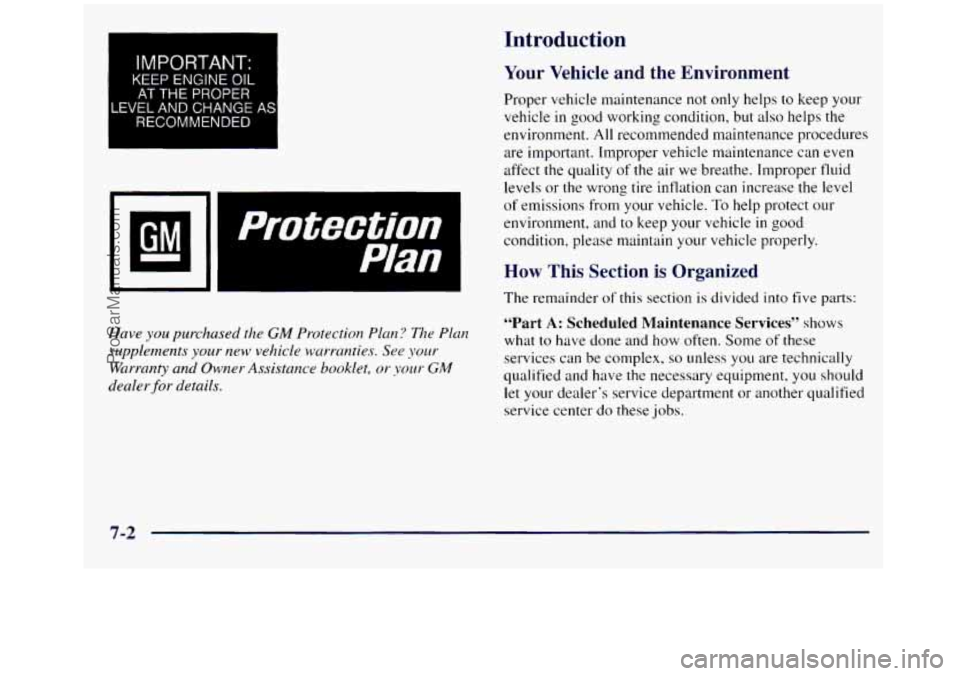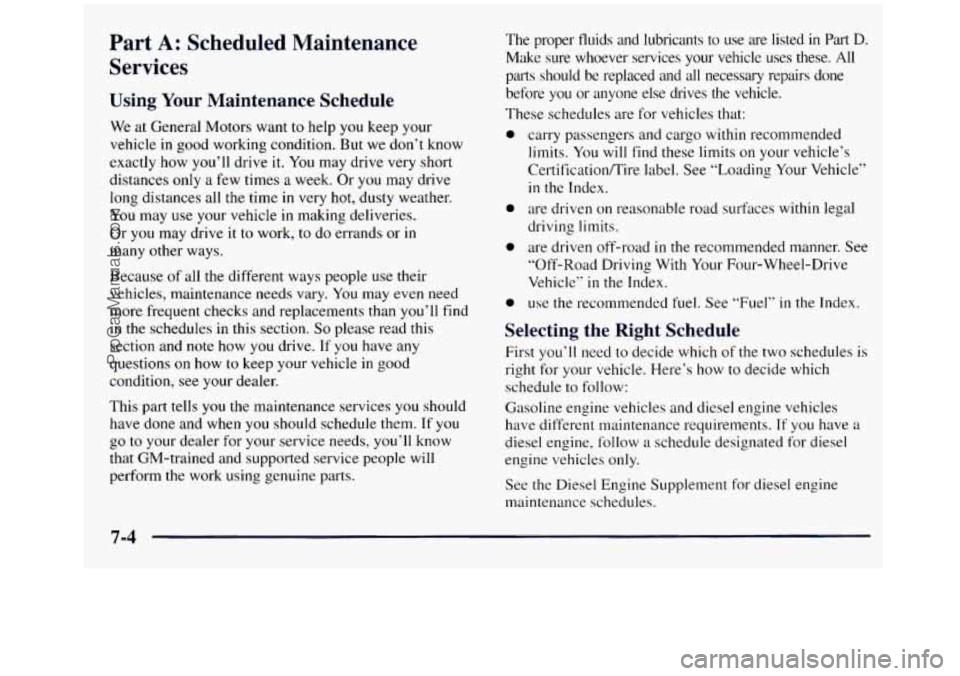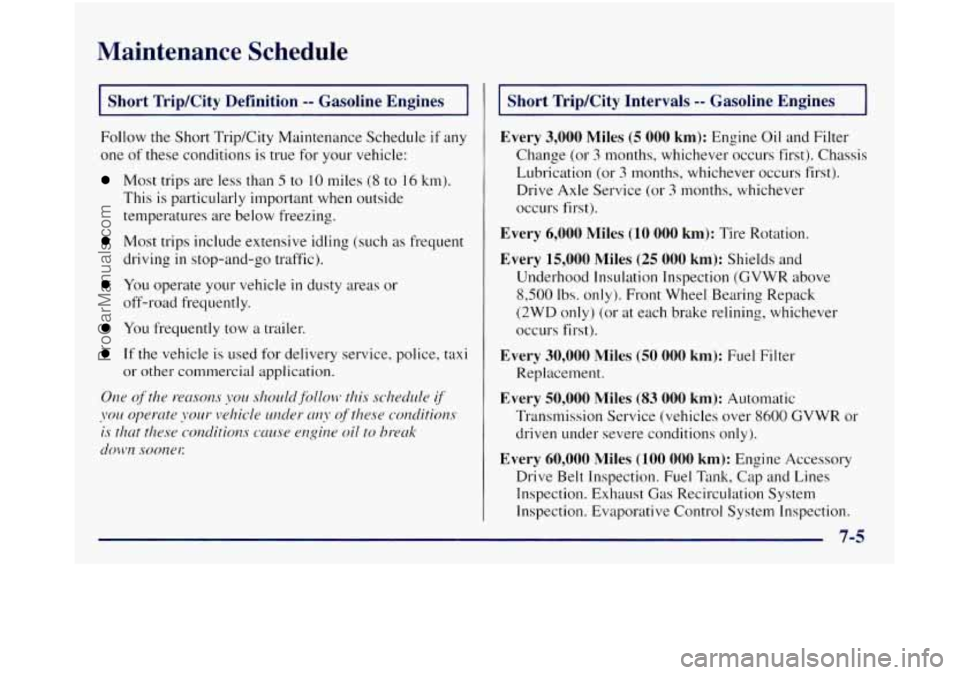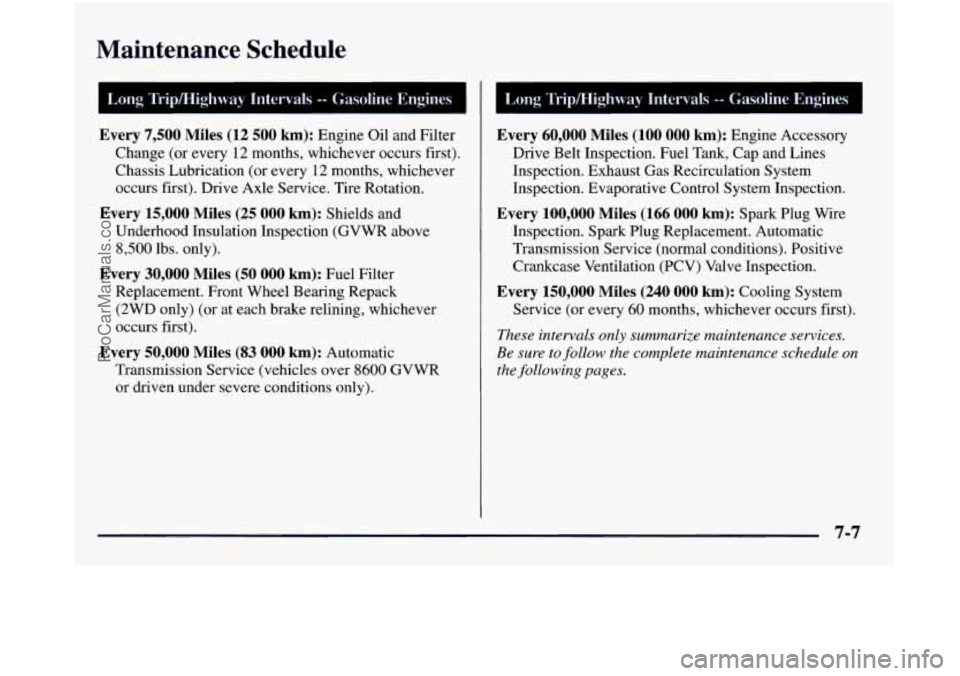Page 317 of 452
Transfer Case
When to Check Lubricant
Refer to the Maintenance Schedule to determine how
often to check
the lubricant. See “Periodic Maintenance
Inspections” in the Index.
How to Check I>--’- --’ :::It
If the level is below the bottom of the filler plug hole,
you’ll need to add some lubricant. Add enough lubricant
to raise the level to the bottom of the filler plug hole.
What to Use
Refer to the Maintenance Schedule to determine what
kind of lubricant to use. See “Recommended Fluids and
Lubricants” in the Index.
Front Axle
When to Check and Change Lubricant
Refer to the Maintenance Schedule to determine how
often to check the lubricant and when to change
it. See
“Scheduled Maintenance Services”
in the Index.
ProCarManuals.com
Page 343 of 452

When to Check
Check your tires once a month or more. Also, check the
tire pressure of the spare tire.
How to Check
Use a good quality pocket-type gage to check tire
pressure. You can’t tell if your tires are properly inflated
simply by looking at them. Radial tires may
look
properly inflated even when they’re underinflated.
Be sure
to put the valve caps back on the valve stems.
They help prevent leaks by keeping out dirt and moisture.
Tire Inspection and Rotation
Tires should be rotated every 6,000 to 8,000 miles
(10 000 to 13 000 km). Any time you notice unusual
wear, rotate your tires as soon as possible and check
wheel alignment.
Also check for damaged tires or
wheels.
See “When It‘s Time for New Tires” and
“Wheel Replacement” later in this section for more
information. If your vehicle has dual rear wheels, also
see “Dual Tire Operation” later
in this section. The purpose
of regular rotation
is to achieve more
uniform wear
for all tires on the vehicle. The first
rotation is the most important. See “Scheduled
Maintenance Services”
in the Index for scheduled
rotation intervals.
1
FRT FRT
[x[
If your vehicle has single rear wheels, always use one of
the correct rotation patterns shown here when rotating
your tires.
If your vehicle has front tires with different load ranges
or tread designs (such as all season vs. on/off road) than
the rear tires, don’t rotate your tires front
to rear.
6-53
ProCarManuals.com
Page 371 of 452
Section 7 Maintenance Sch - dulp
This section covers the maintenance required for your vehicle. Your vehicle needs these services to retain its safety,
dependability and emission control performance.
7-2
7-4
7-5
7-5
7-6
7-7
Introduction
Part
A: Scheduled Maintenance Services
Short Trip/City Definition
Short Trip/City Intervals
Long Trip/Highway Definition
Long Trip/Highway Intervals 7-8
Short Trip/City Maintenance Schedule
7-28 Long Trip/Highway Maintenance Schedule
7-40 Part
B: Owner Checks and Services
7-44 Part C: Periodic Maintenance Inspections
7-46 Part
D: Recommended Fluids and Lubricants
7-49 Part
E: Maintenance Record
ProCarManuals.com
Page 372 of 452

LE
IMPORTANT-
KEEP ENGINE OIL
AT THE PROPER
,VEL AND CHANGE
RECOMMENDED
AS
Have you purchased the GM Protection Pl~rn? The Plan
supplements your new vehicle M:u-ranties. See your
Warranty and Owner Assistance booklet,
or your GM
dealer-for details.
Introduction
Your Vehicle and the Environment
Proper vehicle maintenance not only helps to keep your
vehicle in good working condition, but also helps the
environment.
All recommended maintenance procedures
are important. Improper vehicle maintenance can even affect the quality
of the air we breathe. Improper fluid
levels or the wrong tire inflation can increase the level
of emissions from your vehicle.
To help protect our
environment, and to keep your vehicle
in good
condition, please maintain your vehicle properly.
How This Section is Organized
The remainder of this section is divided into five parts:
“Part A: Scheduled Maintenance Services” shows
what to have done and how often. Some
of these
services can be complex,
so unless YOLI are technically
qualified and have the necessary equipment, you should
let
your dealer‘s service department or another qualified
service center do these
jobs.
7-2
ProCarManuals.com
Page 374 of 452

Part A: Scheduled Maintenance
Services
Using Your Maintenance Schedule
We at General Motors want to help you keep your
vehicle
in good working condition. But we don't know
exactly how you'll drive it. You may drive very short
distances only
a few times a week. Or you may drive
long distances all
the time in very hot, dusty weather.
You may use your vehicle in making deliveries.
Or
you may drive it to work, to do errands or in
many other ways.
Because of all the different ways people use their
vehicles, maintenance needs vary. You may even need
more frequent checks and replacements than you'll find
in the schedules in this section.
So please read this
section and note how
you drive. If you have any
questions
on how to keep your vehicle in good
condition, see your dealer.
This part tells
you the maintenance services you should
have done and when you should schedule them. If you
go to your dealer for your service needs, you'll know
that GM-trained and supported service people
will
perform the work using genuine parts. The proper fluids and lubricants to use are listed
in Part D.
Make sure whoever services your vehicle uses these. All
pats
should be replaced and all necessary repairs done
before you or anyone else drives the vehicle.
These schedules are for vehicles that:
0 carry passengers and cargo within recommended
limits, You
will find these limits on your vehicle's
Certification/Tire label. See "Loading Your Vehicle"
in the Index.
0 are driven on reasonable road surfaces within legal
driving limits.
0 are driven off-road in the recommended manner. See
"Off-Road Driving With Your Four-Wheel-Drive
Vehicle"
in the Index.
0 use the recommended fuel. See "Fuel" in the Index.
Selecting the Right Schedule
First you'll need to decide which of the two schedules is
right for your vehicle. Here's how to decide which
schedule
to follow:
Gasoline engine vehicles and diesel engine vehicles
have different maintenance requirements.
If you have a
diesel engine, follow a schedule designated for diesel
engine vehicles only.
See the Diesel Engine Supplement for diesel engine
maintenance schedules.
7-4
ProCarManuals.com
Page 375 of 452

Maintenance Schedule
Short Trip/City Definition -- Gasoline Engines
Follow the Short Trip/City Maintenance Schedule if any
one of these conditions is true for your vehicle:
Most trips are less than 5 to 10 miles (8 to I6 km).
This is particularly important when outside
temperatures are below freezing.
Most trips include extensive idling (such as frequent
driving
in stop-and-go traffic).
You operate your vehicle in dusty areas or
off-road frequently.
You frequently tow a trailer.
If the vehicle is used for delivery service, police, taxi
or other commercial application.
One oj*tlw reclsorzs yo14 sl~or.~ld~foIlo~~~ this scI~edniv if
you operate yo1.w vehicle urlcler CIIZJ ojthese cor-zditions
is that these cwm1ition.s CCJLIS~ eqirw oil to break
dOC1!12 Sool-zel:
Short Trip/City Intervals -- Gasoline Engines
Every
3,000 Miles (5 000 km): Engine Oil and Filter
Change (or 3 months, whichever occurs first). Chassis
Lubrication (or 3 months, whichever occurs first).
Drive Axle Service (or 3 months, whichever
occurs first).
Every 6,000 Miles (10 000 km): Tire Rotation.
Every 15,000 Miles (25 000 km): Shields and
Underhood Insulation Inspection (GVWR above
8,500 lbs. only). Front Wheel Bearing Repack
(2WD only) (or at each brake relining, whichever
occurs first).
Every 30,000 Miles (50 000 km): Fuel Filter
Every 50,000 Miles (83 000 km): Automatic
Replacement.
Transmission Service (vehicles over
8600 GVWR or
driven under severe conditions only).
Every 60,000 Miles (100 000 km): Engine Accessory
Drive Belt Inspection. Fuel Tank, Cap and Lines
Inspection. Exhaust Gas Recirculation System
Inspection. Evaporative Control System Inspection.
ProCarManuals.com
Page 376 of 452
Maintenance Schedule
I Short Trip/City Intervals -- Gasoline Engines I
Every 100,000 Miles (166 000 km): Spark Plug Wire
Inspection. Spark
Plug Replacement. Automatic
Transmission Service (normal conditions). Positive
Crankcase Ventilation
(PCV) Valve Inspection.
Every 150,000 Miles (240 000 km): Cooling System
Service (or every
60 months, whichever occurs first). Follow this maintenance
schedule
only if none of the
conditions from the Short Trip/City Maintenance
Schedule is true.
Do not use this schedule if the vehicle
is used for trailer towing, driven in a dusty area or used
off paved roads. Use the Short Trip/City schedule for
these conditions.
Driving CI Ldzicle r+*ith CI fL1ly warmed engine urzder
highvvcry conditions
causes engine oil to break
dowm slorvcr.
7-6
ProCarManuals.com
Page 377 of 452

Maintenance Schedule
Long TriplHighway Intervals -- Gasoline Engines
Every
7,500 Miles (12 500 km): Engine Oil and Filter
Change (or every 12 months, whichever occurs first).
Chassis Lubrication (or every
12 months, whichever
occurs first). Drive Axle Service. Tire Rotation.
Every 15,000 Miles (25 000 km): Shields and
Underhood Insulation Inspection (GVWR above
8,500 lbs. only).
Every 30,000 Miles (50 000 km): Fuel Filter
Replacement. Front Wheel Bearing Repack
(2WD only) (or at each brake relining, whichever
occurs first).
Every 50,000 Miles (83 000 km): Automatic
Transmission Service (vehicles over
8600 GVWR
or driven under severe conditions only).
I Long; TripMighway Intervals -- Gasoline Engines I
Every 60,000 Miles (100 000 km): Engine Accessory
Drive Belt Inspection. Fuel Tank, Cap and Lines
Inspection. Exhaust Gas Recirculation System
Inspection. Evaporative Control System Inspection.
Every 100,000 Miles (166 000 km): Spark Plug Wire
Inspection. Spark Plug Replacement. Automatic
Transmission Service (normal conditions). Positive
Crankcase Ventilation (PCV) Valve Inspection.
Every 150,000 Miles (240 000 km): Cooling System
Service (or every
60 months, whichever occurs first).
These intervals only summarize maintenance services.
Be sure to follow the complete maintenance schedule on
the following pages.
7-7
ProCarManuals.com